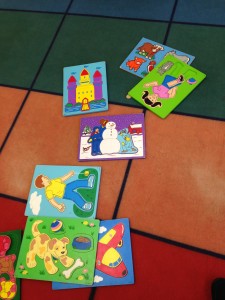From my preceding post:
I read the last line and I think, “It’s first grade, dammit. How far behind can you be?” In these times, the answer’s much different than it was twenty years ago. We are teaching reading and math in kindergarten and even preschool. By first grade, a kid can have fallen appreciably behind now.
This issue will be creating large problems in future classrooms, I believe. We are pushing academic material down, down, down the pipeline. We have three-year-olds in public school preschool programs who are being pushed to learn sight words so they can start to read. They are being given IPads with math programs that include addition and subtraction.
Here is a 1st grade curriculum from a cozy, wood-frame school house in a prosperous Northshore suburb in Illinois:
I consider this curriculum to be age-appropriate overall, especially since the students in this school’s classroom were probably barraged with flash cards and educational computer games almost from the moment they emerged from the womb. Our problem lies in our attempts to teach versions of this curriculum to three-, four- and five-year olds who are not ready to “understand and apply properties of operations” or who are unready to tell time, or describe the relationships between two individuals within a story.
In Finland, children start school at seven years of age. Most have attended preschool, but that preschool heavily emphasizes learning through play. Academics like those above are postponed for a few years, until most or all children are ready for the material coming at them.
To understand the problems that arise from forcing students to begin hard academics at earlier ages, it’s instructive to look at reading. A number of pieces have to come together before reading can begin. Children need to know letters and their sounds — and vowels are a real challenge, sometimes even for adults when they confront unfamiliar words — and then be able to string those letters together to make new sounds. They have to understand how to connect those sounds into a complete word. They have to learn the meaning of various words, some of which will have more than one meaning. Differences in sounds may be subtle. Which witch is which? Some kids can put all of this together at three or four years of age, although that strong, early start remains exceptional. Some perfectly normal kids will not be ready until six or seven years of age to do the same thing. We have ample research documenting these differences.
Finland starts late and manages to be among the top-scoring countries on high school tests in the world. Obviously, a fierce early start on academics is unnecessary to long-term success. One question we ought to be asking ourselves is this: What is the effect of starting rigorous academics too early for subgroups within our classrooms?
I am not saying preschool academics are useless. Especially for students who are entering preschool with a noticeable vocabulary deficit, preschool ought to be mandatory. Vocabulary enrichment ought to be the focus of that preschool.
But as America becomes more diverse, I would suggest we need to look carefully at our students. Those preschool students who are becoming frustrated at their inability to read or do math ought to be let off the hook for awhile, as we backtrack and work on more appropriate skills for their ages and aptitudes. The individual child should determine what is taught — not some pie-in-the-sky district plan.
Eduhonesty: Here’s a big truth that seems to be too often ignored today. Children are naturally hierarchical creatures. From their first days in school, they are always figuring out where they stand with respect to others around them. Who is the better soccer player? Who is the better artist? Who is the better reader?
I am afraid our challenging curricula are convincing some kids they are dumber than the average bear at a very early age. Those kids who are not among the better readers? When we push too hard, we can create a misimpression that has the potential to mess a child up for life. Once a child concludes he’s “dumb,” that view can become a self-fulfilling prophecy without interventions that may not happen, or may not happen in time.




